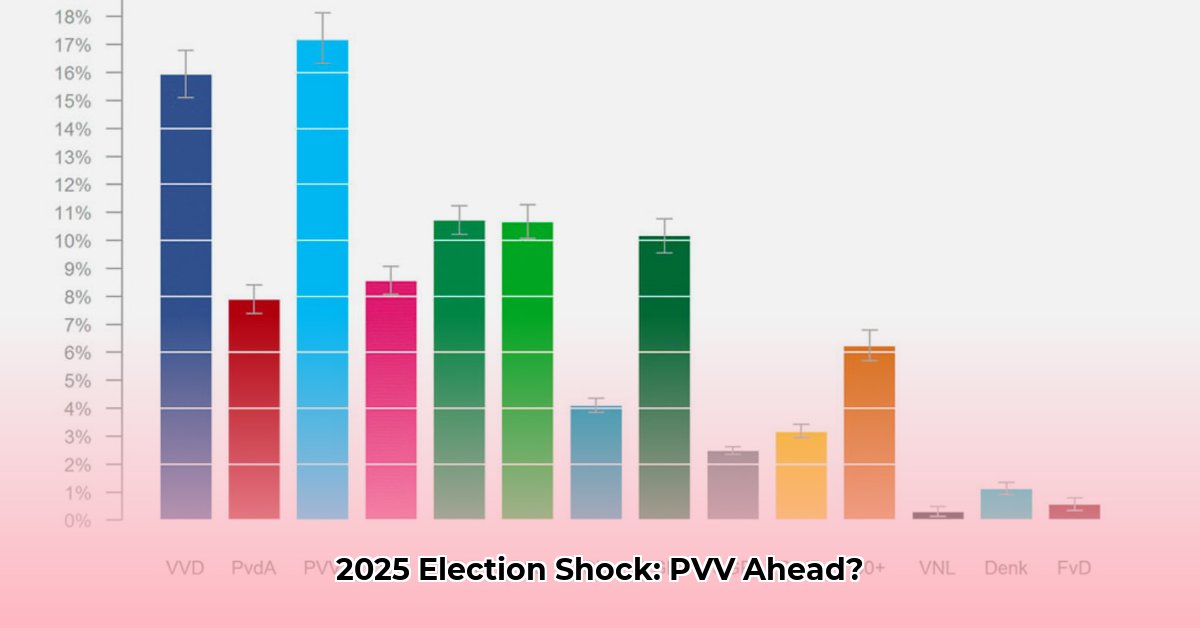
Peilingen Zetels: Decoding the 2025 Dutch Election Polls
The 2025 Dutch elections are looming, and the peilingen zetels (election polls) present a complex picture. While the PVV (Party for Freedom) consistently leads, significant discrepancies exist between different pollsters, making accurate predictions challenging. This article unpacks the intricacies of these polls, examining their methodologies, highlighting key disagreements, and offering a framework for interpreting the data. Understanding these nuances is crucial for navigating the upcoming election's uncertainties.
The PVV's Lead: Solid or Shaky?
Current polls consistently place the PVV at the top. However, projected seat counts vary wildly, ranging from approximately 29 to 37. This substantial range raises questions about the reliability of these predictions and the methodologies employed by different polling organizations. This discrepancy alone highlights the need for careful analysis of the available data. But are these variations merely due to different polling methodologies or do they reflect genuine uncertainties in voter intentions?
Pollster Discrepancies: Methodology Matters
The disparity in predicted seat numbers stems largely from differing polling methodologies. Institutions like Ipsos I&O utilise probability sampling (choosing participants randomly to represent the population), considered a gold standard. Peil.nl, conversely, uses online panels, restricting the data to existing online users. This can skew results, as it might not accurately reflect the opinions of the whole Dutch population. Peilingwijzer, meanwhile, aggregates data from multiple sources. Each methodology carries its own strengths and weaknesses, influencing the final predictions and creating the inconsistencies seen in the results.
The Political Landscape: Post-Cabinet Reshuffle Implications
The recent government collapse significantly impacted the political landscape. The extent of this impact on voter sentiment and the subsequent shifts in polling predictions remain a key area of debate. Some analysts believe it boosted the PVV, while others argue the effect is less pronounced. This emphasizes the challenges in accounting for such recent events in longer-term forecasting. How much weight should we give to this post-cabinet shift when analyzing election forecasts? It is a vital point to consider.
A Deeper Dive into the Numbers
The most significant discrepancies appear in the seat projections for the PVV, GroenLinks/PvdA (frequently polled as a single bloc), and the VVD (People's Party for Freedom and Democracy). This underscores the difficulty of translating raw polling data into precise seat projections, given the complexities of the Dutch electoral system. Are these apparent discrepancies significant in the context of the polls' margins of error? A closer look at the numbers is needed.
Example Poll Comparison:
| Pollster | PVV Seats (Estimated) | GroenLinks/PvdA Seats (Estimated) | VVD Seats (Estimated) |
|---|---|---|---|
| Ipsos I&O | 32-37 | 20-25 | 15-20 |
| Peil.nl | 29-35 | 22-28 | 12-18 |
| Peilingwijzer | 31 | 23 | 17 |
The considerable variation across these estimations highlights the need for cautious interpretation. Drawing definitive conclusions based on any single poll would be premature.
Interpreting Conflicting Poll Data: A Practical Guide
The inconsistencies in polling data highlight the challenges of electoral forecasting. To navigate this complexity, a structured approach is required:
- Source Evaluation: Assess the pollster's reputation, methodology transparency, and track record of accuracy. Is the data verifiable?
- Methodological Scrutiny: Examine the sampling techniques employed. Larger, representative samples generally produce more reliable results. Was there any bias in the selection process?
- Margin of Error Assessment: Consider the margin of error, which often provides a confidence interval, such as +/- 3%. Keep in mind that minor margins of error still allow for significant variations.
- Temporal Considerations: Evaluate the fieldwork timing. Recent elections or events can significantly impact public opinion and thus influence the data. How recent is the polling data?
- Comparative Analysis: Compare results across multiple polls. Look for patterns and consistencies despite the differences. A multi-poll average can smooth out some of the variations.
- Bias Detection: Be aware of potential biases from the pollster or news outlets presenting the results. Always check information from alternative sources.
Looking Ahead: Navigating the Uncertainty
The 2025 Dutch elections remain highly unpredictable. While the PVV's lead is noteworthy, the significant variations in seat projections necessitate careful consideration of the methodologies and the political context. The potential for coalition negotiations and their influence on the final outcome add another layer of complexity. Careful consideration of all available information is crucial when forming an opinion of the likely electoral outcome. Continuous monitoring of the political landscape is vital for understanding the evolving dynamics. This makes the upcoming months critical for observing shifts in public opinion and further refining predictions. The road to 2025 is sure to be an interesting one.